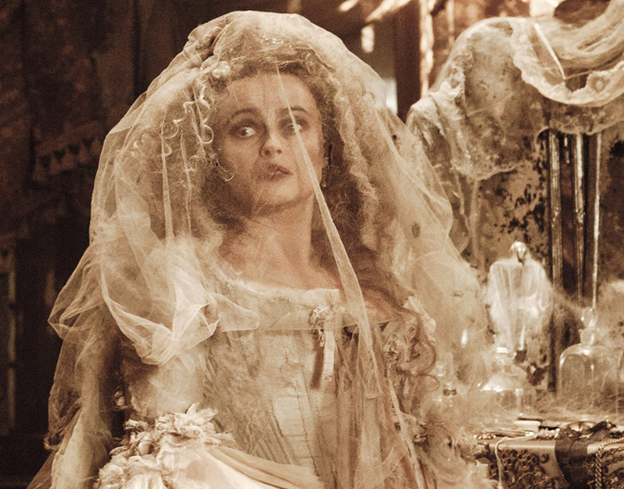Stitching ourselves Together : Cathy Church
Canadian Museum of Civilization

Helena Bonham Carter as Miss Havisham in Great Expectations, 2012. Courtesy BBC Films
Unlike anything else a woman wears, the wedding outfit has a power and irrevocability all its own. The "little black dress", work-out gear, so-called “power dressing”, even the black lace bra, are hardly even in the same league. Is there any other piece of female clothing that has the power to elicit such incredible emotion or judgment as the wedding dress?
In Fabrications: Stitching Ourselves Together Cathy Church attempts to unravel the mystery of her mother’s identity, Lorraine Partlow Church of Lacombe, Alberta, through her life's work - the design and construction of wedding dresses for the women of a small Prairie town.
Looking at the twenty-two dresses, spanning over four decades, I was struck by how extremely rare it is to see such personal clothing, set up as an exhibition in a museum. Usually we’re not looking at the clothing of ordinary people from our own “Canadian” tribe. With the exception of one, all of the owners are still alive. Dress #7, Evelyn Heath Morrice, 1958 whose accompanying story is appropriately entitled, A Story Gone Missing, died of cancer in 1993.
Set up in powder blue and pale turquoise cases, each dress is accompanied by text and image designed like a blue-lined school notebook: on the left page, a photograph of the bride on her wedding day and on the right, a lengthy quotation from the bride. Interestingly, in many of the photographs, the bride is shown alone.
I got drawn into the stories, the dresses becoming something to meditate on afterward. The detail in them is incredible. Just the hems on the dresses, ruler straight. For anyone who’s sewn, working with slippery materials, getting a hem straight is no joke. It's a fascinating collection of remembrances that reveals all the sometimes conflicting desires of the dresses' owners. Simplicity and practicality seem to be the dominant theme in design, but when it comes to looking back at the events surrounding its construction, and the wedding itself, the reminiscences run the gamut. and wanting to meld the owner's personality with the minefield of making "the right choice" in a wedding outfit.
It weaves its own spell of magic—the curator, you see, is Lorraine's daughter Kathryn.
The only disappointment in the presentation is that Lorraine's comments, including her description of the materials she used, are relegated to a notebook on a table. Why weren't her thoughts were not presented alongside the others?
Who can forget the fantastically grotesque and tragic Miss Havisham and her wedding "finery" in Dickens's Great Expectations? Devastated and abandoned on her wedding day, for decades she wears nothing else. While spiders make webs in her wedding cake, all the clocks are stopped precisely at that awful moment forever. And her dress? It's white perfection fades, warps, tears, yellows, becoming a decomposition of its former self, eaten up by time and bitterness, much like its wearer.
Published in The Ottawa Xpress
In Fabrications: Stitching Ourselves Together Cathy Church attempts to unravel the mystery of her mother’s identity, Lorraine Partlow Church of Lacombe, Alberta, through her life's work - the design and construction of wedding dresses for the women of a small Prairie town.
Looking at the twenty-two dresses, spanning over four decades, I was struck by how extremely rare it is to see such personal clothing, set up as an exhibition in a museum. Usually we’re not looking at the clothing of ordinary people from our own “Canadian” tribe. With the exception of one, all of the owners are still alive. Dress #7, Evelyn Heath Morrice, 1958 whose accompanying story is appropriately entitled, A Story Gone Missing, died of cancer in 1993.
Set up in powder blue and pale turquoise cases, each dress is accompanied by text and image designed like a blue-lined school notebook: on the left page, a photograph of the bride on her wedding day and on the right, a lengthy quotation from the bride. Interestingly, in many of the photographs, the bride is shown alone.
I got drawn into the stories, the dresses becoming something to meditate on afterward. The detail in them is incredible. Just the hems on the dresses, ruler straight. For anyone who’s sewn, working with slippery materials, getting a hem straight is no joke. It's a fascinating collection of remembrances that reveals all the sometimes conflicting desires of the dresses' owners. Simplicity and practicality seem to be the dominant theme in design, but when it comes to looking back at the events surrounding its construction, and the wedding itself, the reminiscences run the gamut. and wanting to meld the owner's personality with the minefield of making "the right choice" in a wedding outfit.
It weaves its own spell of magic—the curator, you see, is Lorraine's daughter Kathryn.
The only disappointment in the presentation is that Lorraine's comments, including her description of the materials she used, are relegated to a notebook on a table. Why weren't her thoughts were not presented alongside the others?
Who can forget the fantastically grotesque and tragic Miss Havisham and her wedding "finery" in Dickens's Great Expectations? Devastated and abandoned on her wedding day, for decades she wears nothing else. While spiders make webs in her wedding cake, all the clocks are stopped precisely at that awful moment forever. And her dress? It's white perfection fades, warps, tears, yellows, becoming a decomposition of its former self, eaten up by time and bitterness, much like its wearer.
Published in The Ottawa Xpress

